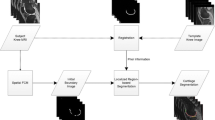Abstract
Hip Osteoarthritis (OA) is a common pathological condition among the elderly population, which is mainly characterized by cartilage degeneration. Accurate segmentation of the cartilage tissue over MRIs facilitates quantitative investigations into the disease progression. We propose an automated approach to segment the hip joint cartilage as a single unit from routine clinical MRIs utilizing a voxel-based classification approach. We extracted a rich feature set from the MRIs, which consisting of normalized image intensity-based, local image structure-based, and geometry-based features. We have evaluated the proposed method using routine clinical hip MR images taken from asymptomatic elderly and diagnosed OA patients. MR images from both cohorts show full or partial loss of thickness due to aging or hip OA progression. The proposed algorithm shows good accuracy compared to the manual segmentations with a mean DSC value of 0.74, even with a high prevalence of cartilage defects in the MRI dataset.
Access this chapter
Tax calculation will be finalised at checkout
Purchases are for personal use only
Similar content being viewed by others
References
Chandra, S.S., et al.: Automated analysis of hip joint cartilage combining MR T2 and three-dimensional fast-spin-echo images. Magn. Reson. Med. 75(1), 403–413 (2016). https://doi.org/10.1002/mrm.25598
Dice, L.R.: Measures of the amount of ecologic association between species. Ecology 26(3), 297–302 (1945)
Fripp, J., Crozier, S., Warfield, S.K., Ourselin, S.S.: Automatic segmentation of the bone and extraction of the bone & cartilage interface from magnetic resonance images of the knee. Phys. Med. Biol. 52(6), 1617–1631 (2007). https://doi.org/10.1088/0031-9155/52/6/005
Gerig, G., Jomier, M., Chakos, M.: Valmet: a new validation tool for assessing and improving 3D object segmentation. In: Niessen, W.J., Viergever, M.A. (eds.) MICCAI 2001. LNCS, vol. 2208, pp. 516–523. Springer, Heidelberg (2001). https://doi.org/10.1007/3-540-45468-3_62
Girard, M., Pedoia, V., Norman, B., Rossi-Devries, J., Majumdar, S.: Automatic segmentation of hip cartilage with deep convolutional neural nets for the evaluation of acetabulum and femoral T1\(\rho \) and T2 relaxation times. Osteoarthritis Cartilage 26, S439–S440 (2018). https://doi.org/10.1016/j.joca.2018.02.843
Johnson, H.J., McCormick, M.M., Ibanez, L.: The ITK Software Guide Book 2: Design and Functionality. Kitware Incorporated, New York (2015)
Lawrence, R.C., et al.: Estimates of the prevalence of arthritis and other rheumatic conditions in the united states. Arthritis Rheum. 58(1), 26–35 (2008). https://doi.org/10.1002/art.23176
Nishii, T., Sugano, N., Sato, Y., Tanaka, H., Miki, H., Yoshikawa, H.: Three-dimensional distribution of acetabular cartilage thickness in patients with hip dysplasia: a fully automated computational analysis of MR imaging. Osteoarthritis Cartilage 12(8), 650–657 (2004). https://doi.org/10.1016/j.joca.2004.04.009
Platt, J.: Sequential minimal optimization: a fast algorithm for training support vector machines (1998)
Ramme, A.J., et al.: Evaluation of automated volumetric cartilage quantification for hip preservation surgery. J. Arthroplasty 31(1), 64–69 (2016). https://doi.org/10.1016/j.arth.2015.08.009
Sato, Y., et al.: A fully automated method for segmentation and thickness determination of hip joint cartilage from 3D MR data. Int. Congr. Ser. 1230, 352–358 (2001). https://doi.org/10.1016/S0531-5131(01)00029-2
Siversson, C., Akhondi-Asl, A., Bixby, S., Kim, Y.J., Warfield, S.K.: Three-dimensional hip cartilage quality assessment of morphology and dGEMRIC by planar maps and automated segmentation. Osteoarthritis Cartilage 22(10), 1511–1515 (2014). https://doi.org/10.1016/j.joca.2014.08.012
Sofat, N., Ejindu, V., Kiely, P.: What makes osteoarthritis painful? The evidence for local and central pain processing. Rheumatology 50(12), 2157–2165 (2011). https://doi.org/10.1093/rheumatology/ker283
Tustison, N.J., et al.: N4ITK: improved N3 bias correction. IEEE Trans. Med. Imaging 29(6), 1310–1320 (2010). https://doi.org/10.1109/TMI.2010.2046908
Van Ginneken, B., Heimann, T., Styner, M.: 3D segmentation in the clinic: a grand challenge, pp. 7–15 (2007)
Xia, Y., Chandra, S.S., Engstrom, C., Strudwick, M.W., Crozier, S., Fripp, J.: Automatic hip cartilage segmentation from 3D MR images using arc-weighted graph searching. Phys. Med. Biol. 59(23), 7245–66 (2014). https://doi.org/10.1088/0031-9155/59/23/7245
Xia, Y., Fripp, J., Chandra, S.S., Schwarz, R., Engstrom, C., Crozier, S.: Automated bone segmentation from large field of view 3D MR images of the hip joint. Phys. Med. Biol. 58(20), 7375–90 (2013). https://doi.org/10.1088/0031-9155/58/20/7375
Xia, Y., Manjon, J.V., Engstrom, C., Crozier, S., Salvado, O., Fripp, J.: Automated cartilage segmentation from 3D MR images of hip joint using an ensemble of neural networks. In: 2017 IEEE 14th International Symposium on Biomedical Imaging (ISBI 2017), pp. 1070–1073. IEEE (2017). https://doi.org/10.1109/ISBI.2017.7950701
Zhang, K., Lu, W., Marziliano, P.: Automatic knee cartilage segmentation from multi-contrast MR images using support vector machine classification with spatial dependencies. Magn. Reson. Imaging 31(10), 1731–1743 (2013). https://doi.org/10.1016/j.mri.2013.06.005
Author information
Authors and Affiliations
Corresponding author
Editor information
Editors and Affiliations
Rights and permissions
Copyright information
© 2020 Springer Nature Switzerland AG
About this paper
Cite this paper
Harischandra, N., Dharmaratne, A., Cicuttini, F.M., Wang, Y. (2020). Voxel Classification Based Automatic Hip Cartilage Segmentation from Routine Clinical MR Images. In: Yang, H., Pasupa, K., Leung, A.CS., Kwok, J.T., Chan, J.H., King, I. (eds) Neural Information Processing. ICONIP 2020. Communications in Computer and Information Science, vol 1332. Springer, Cham. https://doi.org/10.1007/978-3-030-63820-7_69
Download citation
DOI: https://doi.org/10.1007/978-3-030-63820-7_69
Published:
Publisher Name: Springer, Cham
Print ISBN: 978-3-030-63819-1
Online ISBN: 978-3-030-63820-7
eBook Packages: Computer ScienceComputer Science (R0)




